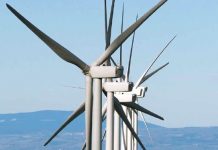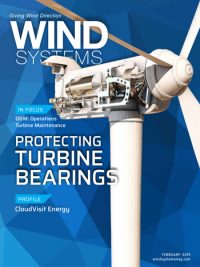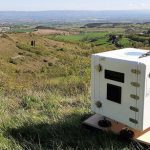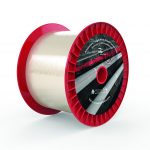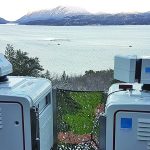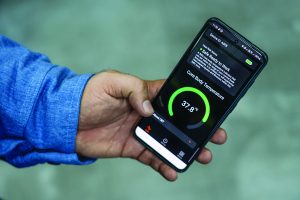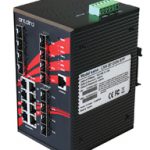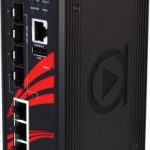Three innovative 20-meter-long rotor blades developed within the context of the SmartBlades2 project will be assessed under natural weather and wind conditions in Boulder, Colorado, over four months. For this purpose, the rotor blades, which were designed by the Fraunhofer Institute for Wind Energy Systems (IWES) and built by the German Aerospace Center (Deutsches Zentrum für Luft- und Raumfahrt; DLR), have been successfully installed in the United States at the Department of Energy’s National Wind Technology Center (NWTC) of the National Renewable Energy Laboratory (NREL).
Among others, the field campaign aims to clarify how well the rotor blades — designed with bend-twist coupling — are able to effectively dampen peak loads during strongly variable wind speeds. The results will serve as a basis for the further development of smart rotor blades. The SmartBlades2 project is funded by the German Federal Ministry for Economic Affairs and Energy (BMWi) and is being carried out by the Research Alliance Wind Energy, with its partners DLR, Fraunhofer IWES, and ForWind, in collaboration with industry partners from GE, Henkel, Nordex Acciona, SSB Wind Systems, Suzlon, Senvion, and WRD Wobben Research and Development.
Longer service life, greater yield
Rotor blades equipped with bend-twist coupling are able to adapt to variating wind conditions by themselves — at higher wind speeds the rotor blades can bend or twist, thus offering the wind a smaller impact surface. This reduces the overall load on the system, increasing the service life of the wind turbine as well as its power yield. In order to be able to fully capture the structural and aerodynamic behavior of the newly developed blades during the field experiment, the project partners integrated specially developed measurement systems into the blades’ structure already during production at the DLR Center for Lightweight-Production-Technology (ZLP) in Stade, Germany.
First analysis under real weather conditions
“We are very excited to observe and find out how our rotor blades behave during these field assessments. This measurement campaign represents the first practical trial for our blade technology,” said SmartBlades2 Project Manager Zhuzhell Montano Rejas of the DLR Institute of Composite Structures and Adaptive Systems. “The findings will also be used to improve simulation models for next-generation wind turbines.”
Fraunhofer IWES is leading the measurement campaign.
“We are using several measurement systems that will allow us to monitor the entire length of the blades in order to capture the deformations, accelerations, and loads they are subjected to,” said Dr. Christian Kress of Fraunhofer IWES, who is responsible for the campaign. “In addition, the air flow around the rotor blades will be recorded at the surface using an aerodynamic measurement system.”
 Inside the rotor blades, various systems designed by DLR, IWES, and SSB Wind Systems will continuously control how the blades behave under the diverse wind loading conditions the turbine will experiment. Furthermore, the turbine’s tower and the nacelle made available by NREL is also equipped with extensive measuring technology, enabling the team to measure the whole system’s behavior in detail.
Inside the rotor blades, various systems designed by DLR, IWES, and SSB Wind Systems will continuously control how the blades behave under the diverse wind loading conditions the turbine will experiment. Furthermore, the turbine’s tower and the nacelle made available by NREL is also equipped with extensive measuring technology, enabling the team to measure the whole system’s behavior in detail.
The resulting measurements will be correlated with data on wind conditions, which will be recorded by the NREL data acquisition systems present on the NWTC’s field and a SpinnerLIDAR (Light Detection And Ranging) measurement device from the Center for Wind Energy Research (ForWind) at the University of Oldenburg. This Lidar is normally installed in the spinner of a wind turbine, but in this case it is set up on top of the nacelle to be able to analyze the wind field both in front and behind the turbine.
With a laser system, the SpinnerLIDAR scans an area of wind field in front of or behind the turbine.
“In this section, the SpinnerLIDAR can measure at over 300 points every second,” said ForWind scientist Prof. Dr. Martin Kühn. “This enables us to measure wind speeds, wind directions, vertical wind shear components, as well as local turbulences with a spatial resolution that cannot be matched with conventional Lidar devices.”
The comparison of the structural behavior measured by the sensors with the wind data will show whether the developed rotor blades achieve the desired behavior. At the beginning of the measurement campaign, the SpinnerLIDAR will measure the incoming wind field while at the end it will also measure the wake flow behind the wind turbine to better understand the influence of the blades on the surrounding environment.
The measurements in the three-bladed Controls Advanced Research Turbine (CART3) provided by NREL, unlike systems used for commercial power generation, will allow the scientists to conduct various validation scenarios, such as an abrupt deceleration of the rotor. On site — on the edge of the Rocky Mountains — the wind conditions can range from very low speeds to powerful gusts in winter and early spring. This will make it possible for the researchers to assess the SmartBlades2 rotor blades under a variety of environmental conditions.
“We are delighted to be able to validate the new rotor blades at our research turbine at the NWTC,” said Andrew Scholbrock, who is responsible for the measurement campaign with the CART3 turbine at NREL. “We are also eager to find out how these rotor blades, designed with bend-twist coupling, perform in practice under real world conditions.”
The partners of the BMWi-funded SmartBlades2 project are hoping that the measurement campaign will yield meaningful findings on the behavior of the new rotor blades. The validation process will start with data analysis while the measurements are still being conducted and will continue until the end of the project, during the autumn of 2019. The project will help to support the wind-energy industry in the further development of rotor blades with bend-twist coupling and is set to pave the way for the implementation of this technology.
More info www.iwes.fraunhofer.de


















